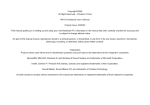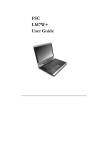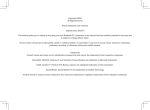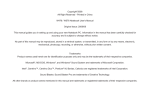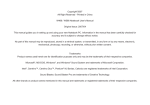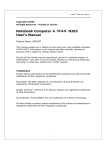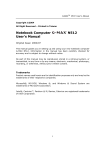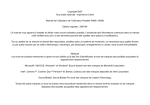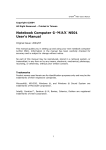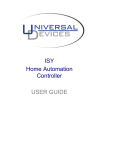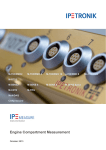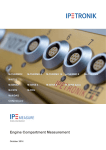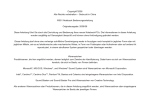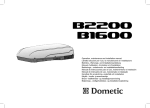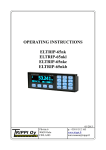Download Printed in China W551 Notebook User`s Manual Original
Transcript
Copyright©2006 All Right Reserved - Printed in China W551 Notebook User's Manual Original Issue: 2006/05 This manual guides you in setting up and using your new Notebook PC. Information in the manual has been carefully checked for accuracy and is subject to change without notice. No part of this manual may be reproduced, stored in a retrieval system, or transmitted, in any form or by any means, electronic, mechanical, photocopy, recording, or otherwise, without prior written consent. Trademarks Product names used herein are for identification purposes only and may be the trademarks of their respective companies. Microsoft®, MS-DOS, Windows®, and Windows® Sound System are trademarks of Microsoft Corporation. Intel®, Centrino™, Centrino Duo™, Pentium® M, Banias, Calexico are registered trademarks of Intel Corporation. Sound Blaster, Sound Blaster Pro are trademarks of Creative Technology. All other brands or product names mentioned in this manual are trademarks or registered trademarks of their respective companies. • Use only the AC adapter and batteries that are supplied by your notebook manufacturer. Using other types of battery or AC adapter may heighten the risk of fire or explosion. • Incorrectly placed batteries may result in an explosion. • Replace only with the same or compatible battery recommended by the manufacturer. • Please discard used batteries according to the manufacturer’s instructions. • Before you connect your notebook to a power source, ensure that the voltage rating of the AC adapter matches that of the available power source. Safety Instructions Use the following safety guidelines to help protect yourself and your notebook. When Using Your W551 Notebook Computer CAUTION: Do not operate your portable computer for an extended period of time with the base resting directly on your body. With extended operation, heat can build up in the base. Allowing sustained contact with the skin can cause discomfort or a burn. ENGLISH - 115 V/60 Hz in most of North and South America and some Far Eastern countries such as South Korea and Taiwan. - 100 V/50 Hz in eastern Japan and 100 V/60Hz in western Japan. - 230 V/50 Hz in most of Europe, the Middle East, and the Far East. • If you use an extension cord with your AC adapter, ensure that the total ampere rating of all devices plugged into the extension cord does not exceed its total capacity. • Do not attempt to service the notebook yourself. Always follow installation instructions closely. • Do not carry a battery in your pocket, purse, or other container where metal objects (such as car keys) could short-circuit the battery terminals. The resulting excessive current flow can generate extremely high temperature and may cause burns to your skin. • Be sure that nothing rests on your AC adapter’s power cable and that the cable is not located where it can be tripped over or stepped on. • While you are using the computer or charging the battery, place the AC adapter in a ventilated area, like on a desktop or on the floor. Do not cover the AC adapter with papers or other items that may prevent ventilation. Also, do not use the AC adapter while it is inside a carrying case. • Do not insert objects into the air vent of your notebook computer. Doing so can cause short-circuiting and may result in fire or electrical shock. • When removing battery from your notebook, first turn off the system, disconnect the AC adapter from the electrical outlet, then remove the battery. • To avoid risk of an electrical shock, do not connect or disconnect any cables, or perform maintenance or reconfiguration of this product during a thunderstorm. • Do not throw batteries into fire, doing so may cause explosion. Check with local authorities first for battery disposal instructions. • When setting up your notebook for work, place it on a level surface. I W551 NOTEBOOK USER’S MANUAL pulled out evenly in order not to bend its connecting pins. Also, before you connect the power cord, make sure that both connectors are correctly oriented and aligned. • Before you clean your notebook, turn it off first, unplug it from its power source, and remove the battery. • Handle interior components with care. When removing a component, please hold it by the edge and not on the connecting pins (such as the memory module). When using your telephone equipments, safety instructions should always be followed in order to prevent fire, electrical shock or injuries, these instructions include: • Do not use this product near water, for example, near a bathtub, washing basins, kitchen/laundry sinks, wet basements or swimming pools. • Avoid using cordless phones during an electrical storm as lightening may cause electrical shocks. • Do not use the telephone to report a gas leak within the leakage area. WARNING: Void of Warranty * If the battery is not properly handled, there may be a risk of explosion; make sure you are using the same or compatible battery. * Please discard used batteries according to the instructions given by the manufacturer. * Please be aware that use of cracked, severely scratched or poor quality discs may damage the optical drive and corrupt data in the disc. Such discs may break while drive operates in highspeed, in this case, your product warranty may be voided. NOTICE: When taking your notebook from a colder to a warmer environment or vice versa, allow your notebook enough time to adapt to the new environment before turning on power. •When unplugging the power cord, please make sure that you pull on its connector or on its strain relief loop, and not on the power cord itself. As you pull out the connector, please ensure that it is II ENGLISH • When traveling, do not check your notebook as baggage. You can put your notebook through an X-ray security machine, but never put your notebook through a metal detector. If you have your notebook checked by hand, be sure to have a charged battery ready in case you are asked to turn on your notebook. • When traveling with the hard drive removed from your notebook, wrap the drive in an insulated material, such as cloth or paper. If you have the drive checked by hand, you may be asked to install the drive into your notebook. Your can have the hard drive checked through an X-ray machine, but never put the drive through a metal detector. • When traveling, do not place your notebook in the overhead storage compartment where it could shift around. Do not drop your notebook or subject it to other mechanical shocks. • Protect your notebook, battery, and hard drive from environmental hazards such as dirt, dust, food, liquids, extreme temperature, and direct exposure to sunlight. • When you move your notebook in environments where there is a substantial difference of temperature or humidity level, condensation may form on or within your notebook. To avoid damaging your notebook, please allow sufficient time for the moisture to evaporate before continue using. Regulatory Notices Federal Communications Commission (FCC) PART 68 Warning This equipment complies with Part 68 of the FCC Rules. On the bottom of the computer is a label that contains, among other information, the FCC Registration Number and Ringer Equivalence Number (REN) for this equipment. You must, upon request, provide this information to your telephone company. FCC Part 68 Registration Number: 6CTTAI - 25876 - FB - E REN: 0.8B Federal Communications Commission Notice This equipment has been tested and found to comply with the limits for a Class B digital service, pursuant to Part 15 of the FCC rules. These limits are designed to provide reasonable protection against harmful interference in a residential installation. ENGLISH Any changes or modifications made to this equipment may void the user’s authority to operate this equipment. This equipment generates, uses, and can radiate radio frequency energy. If not installed and used in accordance with the instructions, may cause harmful interference to radio communications. However, there is no guarantee that interference will not occur in a particular installation. If this equipment does cause harmful interference to radio or television reception, which can be determined by turning the equipment off and on, the user is encouraged to try to correct the interference by one or more of the following measures: ● Reorient or relocate the receiving antenna. ● Increase the separation between the equipment and receiver. ● Connect the equipment into an outlet on a circuit different from that to which the receiver is connected. ● Consult the dealer or an experienced radio/TV technician for help. ● All external cables connecting to this basic unit must be shielded. For cables connecting to PCMCIA cards, see the option manual or installation instructions. The REN is useful to determine the quantity of devices you may connect to your telephone and still have those devices ring when your number is called. In most, but not all areas, the sum of the REN’s of all devices should not exceed five (5.0). To be certain of the number of devices you may connect to your line, as determined by the REN, you should call your local telephone company to determine the maximum REN for your calling area. If your MODEM causes harm to the telephone network, the local Telephone Company may discontinue your service temporarily. If possible, they will notify you in advance. However, if advanced notice isn’t practical, you will be notified as soon as possible. You will be informed of your right to file a complaint with the FCC. Your telephone company may make changes in its facilities, equipment, operations, or procedures that could affect the proper functioning for your equipment. I they do, you will be notified in advance to give you an opportunity to maintain an uninterrupted telephone service. III W551 NOTEBOOK USER’S MANUAL CE Notice (European Union) This symbol indicates this W551 notebook computer complies with the EMC Directive and the European Union’s Low Voltage Directive. This symbol also indicates that W451U meets the following technical standards: The symbol above must be attached to the product indicating compliance with the BSMI standard. • EN 55022 — “Limitations and Methods of Measurement for the Radio Interferences of Information Technology Equipment.” • EN 55024 — “Information technology equipment - Immunity characteristics - Limits and methods of measurement.” • EN 61000-3-2 — “Electromagnetic compatibility (EMC) - Chapter 3: Limits - Section 2: Limits on the harmonic current emissions (Equipment input current up to and including 16 A per phase).” • EN 61000-3-3 — “Electromagnetic compatibility (EMC) - Chapter 3: Limits - Section 3: Limits on the voltage fluctuations and flicker in low-voltage power supply systems for equipment with rate current up to and including 16 A.” • EN 60950 — “Safety of Information Technology Equipment.” CCC Notice (China Only) On Class A systems, the following warning will appear near the regulation label: Warning: This is a Class A product. In a domestic environment, this product may cause radio interference, in which case users may be required to take adequate measures. ENGLISH NOTE: EN 55022 emissions requirements provide for two classificaatios • Class A governs commercial use • Class B is governs residential use BSMI Notice (Taiwan Only) Most notebook computers are classified by the Bureau of Standards, Meteorology and Inspection (BSMI) as Class B information technology equipment (ITE). IV Preface Congratulations on your purchase of a Notebook computer! Your new notebook features the most innovative features in portable computing technology. It combines state-of-the-art ergonomics with sophisticated architecture, providing you with a personal computer that is compact, powerful, and easy to use. Designed for a wide range of general, business, and personal productivity applications, this notebook is an ideal choice for use in the office, at home, and on the road. ENGLISH This Manual contains all the information you need to set up and use your notebook computer, It describes all of its features in a thorough yet easy-to-read manner. V W551 NOTEBOOK USER’S MANUAL Content 4.2 Connecting to an External Monitor via the VGA Port ...........29 4.3 Using the Port Replicator Connector ...................................30 4.4 Using the LAN Port ...............................................................31 4.5 Using the Modem Port ..........................................................31 4.6 Using the IEEE 1394 Port ....................................................32 4.7 PCI Express card/Newcard ...................................................32 4.8 Connecting to the S-Video Port ...........................................33 4.9 SD/MMC/MS/MS Pro Cards .................................................33 4.10 Using your Bluetooth (optional) and Wireless devices. ........33 Safety instructions ......................................................................... I Regulatory Notices ........................................................................ III Preface .......................................................................................... V Chapter 1 The Grand Tour 1.1 The Outside of W551 Notebook Computer ...........................02 1.2 Status LED Indicator .............................................................05 Chapter 5 Troubleshooting 5.1 Frequently Asked Questions .................................................35 Chapter 2 Operating Basics 2.1 Using the Battery Pack .........................................................07 2.2 Connecting the AC Adapter ..................................................08 2.3 Turning Your Notebook On and Off ......................................08 2.4 Installing W551 Device Drivers .............................................09 2.5 Using the Launch Keys .........................................................09 2.6 Keyboad Functions ...............................................................10 2.7 Using the Touchpad ..............................................................13 2.8 Storage .................................................................................14 Appendix A Specifications ............................................................37 Appendix B Service Centers ........................................................39 ENGLISH Chapter 3 Personalize Your W551 Notebook Computer 3.1 How to restore to factory default settings .............................16 3.2 BIOS Settings .......................................................................18 3.3 BIOS Update .........................................................................24 3.4 Graphics Display ...................................................................25 3.5 Protecting Your W551 Notebook Computer .........................27 Chapter 4 Connecting Peripherals 4.1 Using the USB Port ...............................................................29 VI W551 NOTEBOOK USER’S MANUAL This chapter will show you basic components of the computer and briefly explain how they function. The Grand Tour Chapter 1 The Grand Tour ENGLISH 1 1.1 The Outside of W551 Notebook Computer 1 ►Front View◄ The Grand Tour 2 3 4 ENGLISH 5 6 7 8 2 Dual Array Microphone W551 notebook computer comes with a pair of Dual Array Microphones for enhanced audio outputs; particularly when used during video conferences and with voice recognition devices. LCD Glare Type Display Panel LCD is an acronym for Liguid-Crystal Dislay(LCD), which outputs data and images onto its screen. W551’s LCD display panel is a special type called the “Glare Type”, with a mirror-like screen, giving you clearer viewing experiences. Launch Keys Buttons for launching frequently used programs. Light Sensor To activate/ deactivate Light Sensor, press [Num Lk] key first. When Num Lock light (beside Power Button) is on, release [Num Lk] key and press [Fn]+[Home]. Power Button Turn the computer on and off, or resumes whenever it is in suspend mode. Touchpad Use it to move the pointer, select and activate items on the screen. Keyboard Inputs data into your computer. Status LED Indicator (Please refer to Chapter 1.2 below) Light-Emitting Diodes (LEDs) shows the status of the computer's functions and components. W551 NOTEBOOK USER’S MANUAL ►Left View◄ 2 3 5 6 Card reader Accepts SD/MMC/MS/MS Pro Modules (insert only one card at a time). 2 PCI Express Card & New Card Slot Accepts additional New Card-compatible modules. 3 USB Port Connects to USB Devices. 4 Optical Drive Internal optical drive, loads programs from a Compact Disc (CD) or a Digital Versatile Disc (DVD). 5 Optical Drive Indicator The light flickers to indicate activity when the ODD is playing a media disc or is being accessed by the operating system. 6 Optical Drive Eject Button Ejecting the optical drive tray. 7 Emergency Eject Hole Allows to open the optical drive tray without powering on the notebook. 8 Modem Port Connects to a phone jack through an RJ-11 cable. 9 USB Port Connects to USB Devices. 10 Kensington Lock Port Connects a Kensington-compatible security lock. 3 ENGLISH 4 1 Power Port Connect to an AC Adepter. Port Replicator Connector Connects additional peripheral devices to the computer through a universal port. LAN Port The LAN port is used to connect your notebook computer to a Local Area Network (LAN), or to other computers within the network. Externel Display Port Connects to an external monitor. S-Video Port Connects to an external video source, such as television set. USB Port Connects to USB Devices. The Grand Tour 1 ►Right View◄ The Grand Tour ►Front View◄ 1 2 ENGLISH 3 4 5 6 ►Bottom View◄ LCD Latch Locks for the lid. Status LED Indicator (Please refer to Chapter 1.2 below) Light-Emitting Diodes (LEDs) shows the status of the computer's functions and components. Headphone jack Connects to headphones or external speakers or amplifiers. Line-in Jack The line-in jack allows you to connect external audio recording and playback devieces. Microphone Jack Connects to an external microphone. IEEE 1394 Port Connects to your IEEE1394 (Firewire) compatible devices. 1 2 3 4 5 6 Battery Bay Equipped with a Lithium-Ion (Li-Ion) battery pack. Battery Latch Push latch to remove battery. Fan/Heat Vent The built-in fan ventilates heat inside your computer. Stereo Speakers The built-in dual speakers output stereo sound. CPU/Memory/Wireless LAN Card Compartment This compartment contains CPU, Memory, and Wireless LAN modules. Hard Disc Compartment This compartment contains hard disc. ****For warranty reasons, it is not recommended to install and uninstall components on your own, please contact your vendors for more information.**** 4 W551 NOTEBOOK USER’S MANUAL 1.2 Status LED Indicator Num Lock Lights up when the numeric mode is turned on by pressing [Num LK]. Press [Num LK] again to turn off the embedded numeric keyboard. Wireless LAN Activity Indicator The wireless LAN activity indicator tells you whether or not your computer is connected to a wireless network. Hard Disk Drive (HDD) Activity The Hard Disk Drive (HDD) Activity indicator tells you whether your internal hard drive is being accessed and, if so, how fast. Media Card Status Indicator This light flicks when computer is reading a multimedia or SD card. Wireless LAN This indicator tells you whether or not your computer is connected to a wireless network or not. 5 ENGLISH Battery Indicator The battery indicator light tells you whether the Lithumion battery is charging, not charged, or already fully charged. The Grand Tour Caps Lock Lights up when the alphabet keys are locked in uppercase. Press [Caps Lock] to turn on or turn off this mode. Power It glows blue when the computer is on, and flashes blue when the computer is in the suspend mode. The light is off when the computer is completely shut down or in the Hibernation mode. Operating Basics Chapter 2 Operating Basics This chapter will show you how to operate your W551 notebook computer, including connecting the AC adaptor, turning the computer on/off, using touch-pad, keyboard, hot keys, battery, and so on. If you are new to computers and to the operating system, this chapter will guide you through some of the new exciting features. ENGLISH 6 W551 NOTEBOOK USER’S MANUAL 2.1 Using the Battery Pack W551 notebook computer is designed to operate with one of the following power sources: • AC power (using the AC adapter connected to an electrical outlet) • Lithium-Ion (Li-Ion) battery pack Note: The battery can not be charged to 100% when remaining battery is no less than 95%. It is based on the supplier’s advice, and to extend charging frequency and battery life. ►Maintenance of the AC Adapter◄ • Do not connect the adapter to any other device. • Do not step on the power cord or place heavy objects on top of it. Carefully route the power cord and keep cables away from all traffic. • When unplugging the power cord, do not pull on the cord itself but on the plug instead. • If you are using an extension cord, make sure that the devices plugged onto the cord do not exceed its total capacity. Furthermore, the devices plugged into the electrical outlet shall not exceed the fuse’s total ampere rating. • Please verify power voltage before connecting the electrical cord to the power outlet. If you are uncertain of its power specification, please consult with your local vendors or power company for more details. • Operating a fax modem, video, or audio equipment can increase the use of your computer’s power. • Decreasing monitor brightness can also save power. • When the battery is not fully charged, allow your battery to be charged completely before using it (i.e., before disconnecting AC power). Calibrating the battery before use is also highly recommended. • Li-Ion Battery is vulnerable, do not charge it with other power adapter, otherwise fire or explosion may occur. 7 ENGLISH You should use the AC adapter whenever possible; use the battery pack only when AC power is unavailable. The rechargeable LiIon battery pack allows you to operate your notebook computer without an external power source. When you use the AC adapter to connect your notebook to a power outlet, the internal battery will begin to recharge. While the battery is charging, the Battery Charge icon on the indicator panel will be on. Once the battery is fully charged, the Battery Charge icon will turn off. Quick charging time is 2.5 hours for the Lithium-Ion (Li-Ion) battery when the computer is turned off, while the normal battery charging time is 3.5 hours. Operating Basics ►Replacing the Battery◄ The battery will gradually weaken over time. We recommend that you replace your battery when you notice a significant decrease of battery capacity. To change the battery pack, follow the steps below: 1. Turn off the computer. 2. Close the lid and flip the computer over. 3. Slide the side battery latch (1) to the left. Continue to hold it until the battery is removed. 4. Make sure the replacement battery is properly oriented before inserting it into the battery compartment. Operating Basics 2.2 Connecting the AC Adapter 2.3 Turning Your Notebook On and Off The AC adapter converts AC power to DC power and reduces the voltage supplied to the computer. It can automatically adjust to any voltage from 100 to 240 volts and outputs power at 19V, 4.74A for W551N (19V, 3.42A for W551U), allowing you to use your notebook computer in almost any region. ►Turning on the power◄ Open the notebook lid, press and hold the power button for one or two seconds. The power indicator will glow blue once the computer is powered on. ►Turning off the power◄ If you are not going to use your notebook computer for a while, it is best to turn off its power. Before turning off power, close all programs first and shut down the operating system. CAUTION: Use only the AC adapter and the power cord we recommend. Using the wrong adapter may damage your computer. We assume no responsibilities for damages arising from misuse of AC adapters. After turning off your notebook computer, make it a habit to leave the LCD panel open for a while after it has been used for an extended period of time. This allows the interior of your notebook computer to cool off. Closing the panel will force the heat up against the LCD screen, and doing so after a while may damage the screen. More importantly, never close the LCD panel for a long period of time when the computer is on or when the power saving function is disabled. To properly connect the adapter, follow the steps as below: ENGLISH ►Suspend mode◄ You can adjust default power management settings in the Power Option/Advanced dialog box. The Power Options dialog box provides several operating functions after your computer has been idle for a while. 1. Connect the power cord to the AC adapter. 2. Connect the AC adapter to the DC power port of your computer. 3. Connect the AC adapter power cord to an AC outlet. 8 W551 NOTEBOOK USER’S MANUAL 2.4 Installing W551 Device Drivers 2.5 Using the Launch Keys If your W551 Notebook Computer already has an operating system installed, it is best to install all necessary device drivers in order for he hardware to properly function. Before installing drivers, check with your vendors to see if they have already installed all the drivers with the operating system, if not, please follow the steps below: The easy access buttons located on the top of the left side allow you to easily access the internet and your E-Mail client (such as Microsoft® Outlook). There are 5 launch keys found next to the power button: Operating Basics 1. You can find the Utility Driver CD like the one shown below: Fanless Press this button to reduce fan noise (Silent Mode). 2. Put the CD into the CD R-W or DVD-RW (optional) Drive. An Auto Run installation screen will appear. Mute Press this button to mute sound effects. Wireless/Bluetooth Press to activate wireless function. 9 ENGLISH Internet Opens up your Internet Explorer browser. E-Mail This button launches your E-Mail client (such as Microsoft® Outlook). 2.6 Keyboad Functions W551 notebook computer is equipped with a standard typewriterlayout keyboard and has extra features. Operating Basics Basic Keypad Keypad ENGLISH + + Function Desription <Enter> key. Execute a command. Within many text editing programs, the <Enter> key inserts a hard carriage return, just like what an ordinary typewriter does. <Esc> key. Press this key to cancel or escape from a command or function. <Ins> key. Known as the Insert key. Press this key to change from insert to type over mode. <Fn>+<PrtSc> key. Known as the Print Screen key. Press this key to map the whole screen to share memory for your specific usage. <Del> key. Known as the Delete key. Press this key to delete the character to the right of the cursor, or delete marked texts or items. <Num Lk>, <Fn>+<Home> key. <Shift> key. Press this key in combination with letters to produce uppercase letters in typing. Use this key in combination with those two-character keys (found on the second row of the keyboard) to produce the upper marked keys. Also used in most programs in combination with other keys to execute a certain command. <Tab> key. Press this key to move the cursor to the next tab on the right. This key works much the same way as on an ordinary typewriter. <Ctrl> key. Known as the Control key. Used in most programs in combination with other keys to execute a command. <Alt> key. Known as the Alternate key. Used in most programs in combination with other keys to execute a command. To activate/ deactivate Light Sensor. Press <Num Lk> first. When Num Lock light (beside Power Button) is on, release <Num Lk> and press <Fn>+<Home>. <Pause> key. Press this key to temporarily halt execution of a command. Pressing any other keys to resume execution of a command. 10 W551 NOTEBOOK USER’S MANUAL + Special Function Keys <Num Lk> key. Activates the embedded 15-key numeric keypad. <Fn>+<Scr Lk> key. Used in most programs to scroll the screen without having to move the cursor. The keys are in color-coded blue. <Cap Lock> key. Used in most programs to always activate uppercase letters. ►Embedded Numeric Keypad◄ Down arrow key. Moves the cursor down one line at a time. The embedded numeric keypad functions like the one on a desktop keyboard. It is indicated by small characters located on the upper left-hand corner of the keycaps. Left arrow key. Moves the cursor to the left one space at a time. <Home> key. Moves the cursor to the beginning of a screen or line. Desired Access Num Lock On Number keys on embedded keypad Type numbers in a normal manner Cursor-control keys/ Hold Shift while embedded keypad using cursor-control keys <PgUp> key. Moves the cursor up one screen at a time. Num Lock Off Hold Fn while using cursor-control keys Main Keyboard keys Hold Fn while typing Type the letters in a letters on embedded normal manner keypad <PgDn> key. Moves the cursor down one screen at a time. Note: If an external keyboard or keypad is connected to your notebook computer, the Numlock automatically shifts from an internal keyboard to the external keyboard or keypad. <End> key. Moves the cursor to the end of a screen or a line. 11 ENGLISH Right arrow key. Moves the cursor to the right one space at a time. Operating Basics Up arrow key. Moves the cursor up one line at a time. Operating Basics ►Windows Keys◄ Key +[F1] ►Basic keypad◄ you can input letters, numbers, punctuation marks, and special symbols with it. ►Fn Keys◄ By pressing the Fn key with other keys, it can simulate all keyboard functions of a regular desktop keyboard. Description Opens help and support ENGLISH +E Explores my computer +F Finds document +M Minimizes all [Fn]+[F1] [Fn]+[F2] [Fn]+[F3] [Fn]+[F4] [Fn]+[F5] [Fn]+[F6] [Fn]+[F7] [Fn]+[F8] [Fn]+[F9] [Fn]+[F10] [Fn]+[F11] [Fn]+[F12] [Fn]+[Esc] + Shift + M Undoes minimize all +R + Tab Displays run dialog box Activates next taskbar button 12 Suspend switch Activate or deactivate wireless functions Switch between LCD or CRT monitor Increase screen brightness Decrease screen brightness Audio mute Decrease audio volume Increase audio volume Play or pause media player Stop media player Media player skip backward Media player skip forward Enable or disable Bluetooth function W551 NOTEBOOK USER’S MANUAL 2.7 Using the Touchpad ►Double Clicking◄ Move the pointer over to the item with your finger on the pad, and click twice on the left button to select menu items, or simply tap twice on the touchpad. The Touchpad is a pressure-sensitive pointing device that provides all of the features of a two-button mouse; its primary function is to move the cursor around the screen. Touchpad Touchpad buttons ►The Scroll buttons◄ If you are scrolling through the document, you may do so by gliding your finger on the Touchpad while holding the scroll button. ►Clicking◄ You can move the pointer over to the item with your finger on the pad, and click once on the left button below to select it, or simply tap once on the touchpad. 13 ENGLISH You may adjust your Touchpad settings by going into Start/Control Panel /Mouse/Buttons. You can change the Touchpad’s operating orientations through these settings, for example changing from right-handed to left-handed operations. You may also adjust cursor speed as well as response time of mouse clicks. Since the Touchpad is a pressure-sensitive device, therefore proper care should be attended to in order to prevent damage. Please also note the following precautions: • Make sure the touchpad does not come into contact with dirt, liquid or grease. • Do not touch the touchpad if your fingers are dirty. • Do not place heavy objects on the touchpad or on the touchpad buttons. Operating Basics ►To drag and drop◄ Move the pointer over to the item with your finger on the pad, click once on the left button beneath the Touchpad and select the item you want, once the item is selected, you can then drag the item by gliding your finger on the Touchpad (clicking twice on the Touchpad buttons equals to the speed of a double-click on a regular mouse). 2.8 Storage 4. Slide the tray back until it clicks shut. Operating Basics ►Hard Disk◄ W551 notebook computer is equipped with a built-in large capacity 2.5 inch IDE hard disk drive where you store or install your computer operating system as well as software programs. The internal hard disk is normally assigned as Drive C after formatting. 2 1 ENGLISH If you wish to replace your hard disk, contact your local vendor for information about your notebook computer’s hardware setup. You can increase the system’s storage capacity by replacing the standard hard disk drive with a drive of a greater capacity. Always turn off your notebook computer before removing the hard drive. Failure to do so will damage the computer and the hard disk. Avoid jarring or moving your computer while the hard disk is still being accessed. Warning: When the computer is reading from the optical drive, the indicator light for ODD will flash on. Do not attempt to remove the disc while the indicator light is still active. Warning: Do not insert any foreign objects into the disc tray. Do not force the tray to open or close. When the drive is not in use, keep the tray closed in order to prevent dust or dirt from entering the drive. If you experience difficulty when removing a disc, stick a paper clip (or use a pin or a thin metal rod) into the emergency eject hole, the CD disc tray should eject immediately. This procedure can also be used to remove a CD from the drive when the notebook is powered off. Please refer to figure below. ►Optical Disc Drive (ODD)◄ W551 notebook computer is equipped with one of the following optical drives: DVD combo / DVD Dual / DVD Super Multi The optical drive is normally used for installing operating system and software programs. To insert and remove a disc from the drive: 1. Press the button on the front of the drive to eject the disc tray and gently pull out the tray. 2. Place the disc on the tray with label side up. 3. Place the disc on the spindle and press it down gently until the disc clicks into place. 14 W551 NOTEBOOK USER’S MANUAL 15 ENGLISH This chapter will explain how to use the BIOS setup utility. The W551 Notebook Computer has a BIOS setup utility which allows you to configure important system settings. You will also learn how to upgrade components in order to improve system performance. If you have questions about any of these settings, please contact your vendor. Personalize Your W551 Notebook Computer Chapter 3 Personalize Your W551 Notebook Computer Personalize Your W551 Notebook Computer 3.1 How to restore to factory default settings ►Running the cME Version of Recover Pro◄ Once the cME version of Recover Pro is running, follow the steps below. 1. On the menu screen, select Factory Restore, then you will see the Select Recover Type menu. 2. Select a recovery option. • Click on the desired option, or • Press the Tab key until the desired option is highlighted, then press the space bar. 1. Power on your computer. If it is already running, reboot it (restart/ reset). 2. As soon as you see things (logo, graphic, text) start to appear on the screen, press and hold down the F9 key. (Typically, F9 is the “hot key” that starts Recover Pro. Contact your PC manufacturer in case this key does not work.) ENGLISH Recover Boot Partition—Select this option if you know that your hard drive is already partitioned into several drives, if you would like to recover only the boot partition, then select this option. However, the Recover Boot Partition option may not be available to all computers. Recover Full Drive—Select this option if your drive has never been partitioned and/or you want to recover the entire drive. The entire primary drive (usually C:) will be recovered. Cancel and Exit—Select this option if you do not want to run FirstWare Recover Pro at this time. The cME Console screen will then appear. This screen is for accessing the cME application. Your Phoenix cME Console opening screen may not match the one shown above, and the number of available applications may also vary. • If you are unsure which option to choose and want to minimize the number of deleted files, first select Recover Boot Partition. • If, after selecting the first option, the recovery process does no successfully restore your operating system, run FirstWare Recover Pro again, and select the second option - Recover Full Drive. • It is recommended that you not choose Recover Boot Partition if the drive does not already contain a partition. • Under normal circumstances, your can click and select menu options with your mouse when running FirstWare Recover Pro. If for whatever reasons your mouse is not functioning, then press the Tab and the Enter keys to highlight and select the desired option. 16 W551 NOTEBOOK USER’S MANUAL After you select an option, a confirmation dialog box (identical or similar to the one shown here) will appear. • Percentage of recovery completed • Time elapsed • Estimated time remaining The time it takes FirstWare Recover Pro to complete the recovery process ranges from 15 minutes to an hour, depending on the size of the recovery image. The more applications and utilities that were included in the factory setup, the longer the process will take. Start the recovery process, and the FirstWare Progress screen will appear. No further selections are required at this time. • Amount of data (in Kilobytes) to be recovered Cancel—If you select Cancel, the recovery process will stop, yet the system will become unbootable. It is recommended that you select Cancel only when you plan to delay the recovery process. After running FirstWare Recover Pro, the system will be returned to the basic factory setting. If you recover the entire hard drive (not just a boot partition), all data (fi les) you have created and stored on your system’s hard drive, as well as all programs previously installed will be lost. ►Monitoring the Recovery Process◄ While the FirstWare Recover Pro Progress screen is updating, you can monitor its recovery progress. The screen will display several types of information during the recovery process: The start-up of the operating system indicates success of the recovery process. The operating system should now be working, and factory-installed applications should now be available and functional. However your personal files are no longer available. FirstWare Recover Pro will remain in the protected area of your computer system in case you need to run it again in the future. 17 ENGLISH ►Successful Recovery◄ When the recovery process is successfully completed, the following situations will take place automatically: • The progress screen will disappear once the FirstWare Recover progress reaches 100%. • The computer will reboot. • Operating system will start, and desktop will appear. Personalize Your W551 Notebook Computer 3. Confirm that you want to continue. Click Yes to begin the recovery process. Or—if not using the mouse—press Tab to select and then press the space bar. (Selecting No will bring you back to the previous screen from which you can exit FirstWare Recover Pro.) Personalize Your W551 Notebook Computer 3.2 BIOS Settings ESC The BIOS setup utility allows you to configure your computer’s basic settings. When you turn on your computer, the system reads the configuration information and initializes hardware in order for the system to operate properly. You can use the BIOS setup utility to change your computer’s start-up configuration. For example, you can change the security and power management settings for your computer. Users are allowed to enter new values to replace the default values in certain fields, and the rest is considered to be system defaults and cannot be modified. To change settings in the Main Menu, press the Enter key to enter into submenus. To return to the previous screen, press the Esc key. You can only enter the BIOS setup utility only when the computer is turned on, in another word, between the time it’s turned on and before the Windows splash screen appears. If your computer is already turned on, reboot your computer and press the F2 key to enter the setup utility. ENGLISH ►Navigating and Entering Information in BIOS◄ Use the following keys to move between fields and to enter information: Item ←→ Description Select Screen ↑↓ Push the up and down arrow keys to move among selections, then press Enter to make a selection. +- Change Option F1 General Help F10 Save and Exit In any area, you can simply Press Esc to exit. If you wish to exit the BIOS utility without saving changes, go to the main menu, then press Esc. 18 W551 NOTEBOOK USER’S MANUAL ►The Main Menu◄ BIOS SETUP UTILITY Main Advanced System Time: System Date: Security [23:43:17] [01/01/2006] ] Info • System Time & System Date: To change time & date of the system. Exit Item Specific Help • SATA Hard Drive To configure SATA HDD of the notebook. <TAB>,<Shift-Tab>,or <Enter>Selects field. • CD-ROM/DVD-ROM To configure your Optical Disc Drive. Note: SATA Hard Drive and CD-ROM/DVD-ROM have been configured for this notebook. Under normal conditions please do not change the configuration. Personalize Your W551 Notebook Computer ► SATA Hard Drive: [ST98823AS ► CD-ROM/DVD-ROM: [None] Boot ENGLISH F1 Help ↑↓ Select Item -/+ Change Values F9 Setup Defaults ESC Exit← Select Menu Enter Select►SubMenu F10 Save and Exit 19 ►Advanced Menu◄ BIOS SETUP UTILITY Main Advanced Security Boot Info Exit ►Video Features ►Internal Devices Configurations Personalize Your W551 Notebook Computer • Video Features To select options for video display. You can select display device (LCD, CRT, LCD+CRT) and TV Mode (NTSC or PAL) in the SubMenu. Plug & Play O/S: [WinXP] USB BIOS Legacy Support: ATA Control Mode: [Enabled] [Enhanced] Item Specific Help Select options for video display ENGLISH • Internal Devices Configurations To select options for advanced chipset features. You can enable/ disable the following devices in the Sub-Menu: ■ CD-ROM/DVD-ROM controller ■ USB Host Controller ■ Bluetooth ■ Audio controller ■ LAN controller ■ Wireless LAN controller ■ New Card Controller ■ Card Reader and 1394 Controller • Plug & Play OS To select the operating system installed in your system. F1 Help ↑↓ Select Item -/+ Change Values F9 Setup Defaults ESC Exit← Select Menu Enter Select►SubMenu F10 Save and Exit • USB BIOS Legacy Support To enable or disable support for USB keyboards and mice. • ATA Control Mode To configure ATA Control to Compatible Mode or Enhanced Mode. 20 W551 NOTEBOOK USER’S MANUAL ►Security menu◄ Main Advanced Security Boot Supervisor Password User Password Is: HDD Password HDD Master ID Clear Clear Clear 19893855 Supervisor Password User Password HDD Password [Enter] [Enter] [Enter] Password on boot: [Disabled] Info Exit Item Specific Help Supervisor Password controls access to the setup utility • User Password You can enter into the setup utility to change or remove user passwords; however, you can not change or remove the Supervisor Password, nor can you access the diskette. F1 Help ↑↓ Select Item -/+ Change Values F9 Setup Defaults ESC Exit← Select Menu Enter Select►SubMenu F10 Save and Exit • Password on boot A Supervisor Password is required before you set Password on boot. 21 ENGLISH • HDD Password To input, change, or disable hard drive password. When shown as [Locked], the hard drive password currently can not be changed or disabled. To change or disable the function, turn off the system and enter Setup right after turning it back on. * Please remember the password when you decide to use HDD Password. Your notebook service center may not be able to restore the HDD once the password is missing. Personalize Your W551 Notebook Computer • Supervisor Password A Supervisor Password is required before you set User Password. After selecting Change Supervisor Password, enter a new password then re-enter it to confirm. The password you enter should contain up to 6 alphanumeric characters. If you make a mistake while entering your password, you can always press Esc to start over. BIOS SETUP UTILITY ►Boot menu◄ BIOS SETUP UTILITY Personalize Your W551 Notebook Computer Main Advanced Security • Boot Menu To enable or disable Boot Menu Boot Info Exit Item Specific Help • Boot Time Diagnostic Screen To choose screen display during boot. Disabled- display Logo screen during boot. Enabled- display Diagnostic screen during boot. Boot Menu: [Enabled] Boot Time Diagnostic Screen: [Disabled] T h e B o o t M e n u Preboot Execution Environment:[Enabled] Disable or Enable ►Boot Device Priority • Preboot Execution Environment To enable or disable boot from network server. • Boot Device Priority To configure order of boot devices. ENGLISH F1 Help ↑↓ Select Item -/+ Change Values F9 Setup Defaults ESC Exit← Select Menu Enter Select►SubMenu F10 Save and Exit 22 W551 NOTEBOOK USER’S MANUAL ►Exit menu◄ BIOS SETUP UTILITY Main Advanced Security Info • Exit Saving Changes To exit system BIOS setup and save the changes to CMOS. Exit Item Specific Help • Exit Disregarding Changes To exit utility without saving BIOS setup data to CMOS. Exit System Setup and save your changes to CMOS. • Load Setup Defaults To load default values for all BIOS setup items. • Discard Changes To load previous values from CMOS for all BIOS setup items. • Save Changes To save BIOS setup data to CMOS. Personalize Your W551 Notebook Computer Exit Saving Changes Exit Discarding Changes Load Setup Defaults Discard Changes Save Changes Boot ENGLISH F1 Help ↑↓ Select Item -/+ Change Values F9 Setup Defaults ESC Exit← Select Menu Enter Select►SubMenu F10 Save and Exit 23 3.3 BIOS Update 3. Run the setup.exe in your unzipped folder. 4. After you have successfully installed WinFlash, click Start→ Programs, locate the WinFlash program folder, then click on WinFlash. Personalize Your W551 Notebook Computer W551 notebook computer uses the EPROM Flash BIOS chip that allows you to easily update system BIOS. When you update BIOS, you will lose all settings you customized. Please go to the Gigabyte website (http://www.gigabyte.tw) for the latest BIOS update utility. To update BIOS in DOS: 1. Insert the disk with BIOS updated into the diskette drive. (USB FDD, USB Flash Disc, or Floppy Disc) 2. Power on the system with the diskette in the diskette drive. 3. In DOS prompt, type the following command. ENGLISH A:\>Phlash16 xxxx.wph /s /c /mode=3 ou A:\>XXXXXX.BAT (Fichier Batch pour BIOS) 5. Choose the desired option. Selecting “Backup BIOS and Flash BIOS with new settings” will erase all previous settings. Specify the location of your backup and new BIOS files. Click on Flash BIOS when ready. fichier 4. The system will now run the BIOS update. 5. The system will restart automatically once the update is completed. To update BIOS in Windows: 1. Please go to http://www.gigabyte.com.tw (Home > Support > Notebook > BIOS > W551) to download BIOS update tool (WinPhlash) and the latest BIOS upgrade utility. 2. Unzip the file you just downloaded. 24 W551 NOTEBOOK USER’S MANUAL 3.4 Graphics Display 6. Click on OK to start running the program. Your computer has a high-performance graphics display system, which can easily handle the demands of today’s multimedia computing. 7. Flash progress will be shown in the pop-up window. Please do not interrupt the process in order for the program to run correctly. Note: Using a lower resolution than the screen was designed for will reduce the displaying area. Using the computer in DOS mode produces the same effect, because it uses a 640 by 480 resolution by default. 8. The system will now be restarted to complete the process. ►Dual Displays◄ Under Windows operating system, you may use an external monitor and your notebook’s LCD screen simultaneously. You may also choose to only use the external monitor with the LCD disabled or vice versa. 25 ENGLISH Resolution 1. Click My Computer/Control Panel/Appearance and Themes/ Display. Click on the Settings tab. The dialog box will display your monitor’s current resolution. 2. Under “Screen resolution,” use the slide bar to adjust monitor’ s resolution. Normally, you should use the resolution your LCD monitor was designed for. Personalize Your W551 Notebook Computer ►Screen Controls◄ Brightness Function keys can increase or decrease the brightness of the monitor. • <Fn> + <F4> decreases the LCD panel brightness. • <Fn> + <F5> increases the LCD panel brightness. Personalize Your W551 Notebook Computer 1. Open Control Panel. 2. Double-click on Display. The Display Properties window will open. 3. Click on the Settings tab. 4. Click on the Advanced button. ■ W551N Click on GeForce Go 7400 tab. Choose nView Display Settings to adjust. ENGLISH Single Display (for both W551N and W551U) In Single Display mode, you can choose which device to apply as the Primary display. The video display hot keys are available. You can select different video outputs by pressing Fn+F3 repeatedly. Clone (for W551N) Extended Desktop (for W551U) In Clone/Extended Desktop mode, the video display hot keys are available. You can select different video outputs by pressing Fn+F3 repeatedly. If the external monitor is connected, the display on LCD and external monitor is the same. Dualview (for W551N) Dual Display Clone (for W551U) In Dualview/Dual Display Clone mode, choose the monitor for extended display. Dualview/Dual Display Clone mode is controlled by the driver. You can adjust the type of video output in the Menu. Fn+F3 has no switch function under this mode. ■ W551U Choose Intel Graphics Media Accelerator Driver for mobile. Click Graphics Properties to adjust. 26 W551 NOTEBOOK USER’S MANUAL Tip: In order to ensure problem-free video display, when you use an external monitor, change the output mode in the Display properties dialog box first. After changing the output mode, you can then use the video display hot keys. Personalize Your W551 Notebook Computer Note: Light or dark pixels may appear on the LCD screen as a result of LCD’s manufacturing limitations, however, this will not effect your LCD screen’s normal functions. 3.5 Protecting Your W551 Notebook Computer W551 Notebook Computer provides both hardware and software security locks to protect your computer. ENGLISH Using a security lock: A security lock notch can be found on the right side of the computer. This notch allows you to connect a Kensington-compatible security lock to it. 27 Connecting Peripherals Chapter 4 Connecting Peripherals This chapter will show you step-by-step how to connect your peripherals to the W551 notebook computer. ENGLISH 28 W551 NOTEBOOK USER’S MANUAL 4.1 Using the USB Port 4.2 Connecting to an External Monitor via the VGA Port 29 ENGLISH The notebook comes with a VGA port for you to connect to an external monitor. To connect an external monitor, please follow the steps below: 1. Turn off your W551 notebook and make sure the monitor power switch is turned off. 2. Connect the connector cable of the monitor to the VGA port on the left side of your notebook. Secure the cable connection with the screws provided. 3. Connect the monitor power cable and plug it into a properly grounded wall outlet. 4. Turn on the monitor. 5. Turn on your W551 notebook. Both the LCD panel and the monitor screen will show the display. Your notebook is set at default to run at simultaneous display mode. 6. If you only want to show the display on the external monitor (CRT/LCD) and shut off the LCD display, you can use the <Fn> + <F3> hot-key to switch display type between LCD and CRT. Keep pressing the hot-key until you get the display to external CRT/LCD only. Connecting Peripherals The USB port allows multiple peripherals to run simultaneously on a single computer. These peripherals may include: floppy drives, mouse, digital cameras, scanners, printers, optical disk drive, keyboards, and games devices...etc. The USB Port can also act as a hub or as an external workstation. 4.3 Using the Port Replicator Connector 1. DC Power Port Lets you connect the AC power adapter in supplying continuous power to your Port Replicator. Port Replicator Connector allows you to connect an external port replicator devices (optional). This external device is an easy onestep connectivity solution whether at home or the office. 2. 1394 Port The 1394 port allows you to connect IEEE 1394 devices. Connecting Peripherals 3. Serial Port The serial port, or COM port, allows you to connect serial devices, such as printers or scanners. 4. External Monitor Port The external monitor port allows you to connect an external monitor. 5. Parallel Port The parallel port, or LPT port, allows you to connect parallel devices, such as a printer to your notebook. ENGLISH 6. USB V2.0 Port The two USB ports allow you to connect USB devices such as external game pads, pointing devices, key boards and/or speakers. 7. RJ45 10/100/1000Mbps Ethernet LAN Port Internal LAN port connects your notebook to other computers/ networks through a local area network (LAN) and supports data transfer rates at 10 Mbps and can be up to 100Mbps. 8. Stereo Line-out Port The optional stereo line-out port allows you to connect a set of speakers or a headphone to your notebook. 9. Power Switch To power up or off the port replicator. 30 W551 NOTEBOOK USER’S MANUAL 4.4 Using the LAN Port 4.5 Using the Modem Port 1. Connect one end of the cable into the network wall outlet or the HUB. 2. Connect the other end of the cable into the computer’s LAN port. The built-in fax/data modem allows you to connect a phone line to a phone jack. Connecting Peripherals ENGLISH 31 Connecting Peripherals 4.6 Using the IEEE 1394 Port 4.7 PCI Express card/Newcard With the built-in IEEE 1394 port, you can connect your IEEE 1394compatible peripherals for video transmission or data backup. The Windows operating system will automatically recognize the device and install appropriate driver(s) for it. Yet it is still recommended to install the drivers that came with your peripherals. For more The PCI Express card (or Newcard) slot can be used as an interface between your computer and a variety of communication devices, such as network adapters, fax/modems or external storage devices. ►Inserting a Card◄ 1. Insert the card with label side up, make sure that the metal connector is inserted into the card slot. 2. Insert the card into the slot. You will feel some resistance as the card reaches to the end. 3. Your PCI Express cards require drivers, or programs that allow the operating system to use the device. Your Windows operating system should already contain the driver for your device, if not, you will be prompted to install the driver. information, please refer to your hardware manuals. ENGLISH ►Removing a Card◄ 1. Press the eject button on the card slot to release the eject button, then press the eject button again to release the card. 32 W551 NOTEBOOK USER’S MANUAL 4.8 Connecting to the S-Video Port 4.10 Using your Bluetooth (optional) and Wireless devices. Your W551 notebook computer comes with an S-Video port which allows you to connect your computer to an external television set. This is possible by using an S-Video cable: ****For how to connect your Bluetooth and wireless device to your computer, please refer to the manual from your hardware manufacturers.**** Connecting Peripherals Your W551 computer supports both Bluetooth and Wi-Fi compatible devices. To enable both wirless and Bluetooth functions at first, please press the wireless Launch key which is located on the top of the left side. Therefore, you can press Fn+Esc to enable or disable Bluetooth function only and press Fn+F2 to turn on/off wireless function only. ENGLISH 4.9 SD/MMC/MS/MS Pro Cards Multimedia card slot is located on the right side of your W551 notebook computer, it accepts SD/MMC/MS/MS Pro cards. 33 Troubleshooting Chapter 5 Troubleshooting In this chapter, we will list some frequently encountered technical problems and tell you how to resolve them. ENGLISH 34 W551 NOTEBOOK USER’S MANUAL 5.1 Frequently Asked Questions the volume bar. My computer switches to hibernation mode much too quickly kind of external microphone can I use with my notebook What computer? and I have to constantly hit a key or move the mouse to bring back the screen. What can I do? You will need to use a self-amplifying microphone. This is part of Windows Power Management. Access Power Management by clicking on Start / Control Panel / Performance and Maintenance / Power Options, and change the time next to the “Turn off monitor” option to the time you want. You have the choice of either adjusting time for the power supply or for the battery. There are echoes coming from my speakers. What can I do? Because of a software problem, I was unable to shut the I’ve heard that cleaning and rearranging files on the hard drive computer down from Windows, I pressed the power button to power off the computer, but it didn’t work. How can I force a power off? will improve program’s launch speed. How do I do this? Make sure you press the power button for at least 4 seconds. Normally, this will force the computer to shut off. Why can’t I charge the battery of my notebook computer after it is out of use for some time? After your notebook computer has not been used for a long time (for example: more than one month), the battery will enter into low voltage protection mode. Under this circumstance, restoring to normal voltage will require the battery to be slowly charged for several hours. Once the battery has been fully charged, your computer will resume to normal operation. The dial tone volume of the internal fax/modem is too low. How can I increase its volume? Go to Start/Control Panel/Sounds, Speech, and Audio Devices, under Device volume, adjust your speaker volume by controlling 35 ENGLISH Good disk maintenances can improve program launch speed. This normally includes deleting unnecessary files, and defragmenting hard disk so that files can be more efficiently grouped. Windows contains maintenance utilities for these tasks; run Disk Cleanup to remove unnecessary files, and Disk Defragmenter to defragment fragmented file blocks. For more information about these utilities, please refer to your Windows documentation. Troubleshooting Double click on the Speaker icon on the task bar. Then, under Microphone Balance, check the Mute box. Caution Unplugging or ejecting a device that supports safe removal without first using the Safe Removal application to warn the system can cause data to be lost or your system to become unstable. For example, if a device is unplugged during a data transfer, data loss is likely. If you use Safe Removal, however, you can warn the system before you unplug or eject a device, preventing possible loss of data. My computer says: “CMOS Battery Low”, what should I do? Troubleshooting If your computer is without power (i.e. unplug the computer power source from the power outlet and remove the battery pack from it) for over 45 days, you would lose the information stored in CMOS. Please follow the steps below to reconfigure your CMOS settings: 1. Press F2 to enter into the BIOS setup utility. 2. Select “Load Optional Defaults?”. When you see the following prompt, choose <OK> and then press <Enter>. 3. Select “Save Changes and Exit”, select <OK> and press <Enter> to restart your computer. Note For removable storage devices that can safely be removed while the system is on, the system disables write caching by default. It does this so the devices can be removed without loss of data. When write caching is disable, however, the system will likely experience slower performance, so be sure to enable write caching when you have finished removing the device. How to unplug or eject devices ENGLISH 1. In the notification area next to your task bar, double-click the Safe Removal icon. Safe removal displays a list of Plug and Play devices that support safe removal and that are currently attached to the system. If you do not see the Safe Removal icon, your device does not support safe removal, and you cannot unplug or eject your device using Safe Removal. 2. In Safely Remove Hardware, in the list of devices, select the device that you want to unplug or eject, and then click Stop. This tells the system that you will be unplugging or ejecting the device. 3. In Stop a Hardware device, click OK. A notification appears stating that it is now safe to unplug or eject the device. 36 W551 NOTEBOOK USER’S MANUAL Appendix A Specifications Appendix This appendix lists technical and hardware specifications of your W551 notebook computer. Please note that the information mentioned here may not completely match your notebook computer’s actual specifications. Specification is subject to change without notice, and the present manual may be modified at a later time. ENGLISH 37 Microprocessor • Intel® Yonah® Dual Core Processor T2300~2700 • Intel® Yonah® Single Core Processor T1300~1400 • Intel® Celeron® M Processor 410~430 Connectivity • Intergrated 10/100/1000 Mbps Fast Ethernet connection • Built-in 56Kbps V.92 fax/data modern • Four Universal Serial Bus (USB) 2.0 ports • Dual band antenna WLAN Intel ® PRO/Wireless 3945ABG, IEEE 802.11a+b+g (Option) Appendix L2 Cache • Intel® Yonah® Dual Core Processor T2300~2700 (L2 cache 2MB) • Intel® Yonah® Single Core Processor T1300~1400 (L2 cache 2MB) • Intel® Celeron® M Processor 410~430 (L2 cache 1MB) Audio • Built-in High Definition Audio • Built-in two stereo speakers Dual Array Microphone • Separate audio ports for headphone-out and microphone-in devices Core Logic • Intel® 945PM/ ICH7-M (W551N) • Intel® 945GM/ ICH7-M (W551U) Keyboard and pointing devices • 86-key US/87-key EU/90-key JP with Windows function keys • Ergonomically-centered touchpad pointing device with scroll function Graphics • nVIDIA® Geforce Go 7400 128MB (W551N) • Intel® Graphics Media Accelerator (GMA) 950 (W551U) ENGLISH I/O ports • One IEEE 1394 Port • One RJ-11 phone jack (V.92, 56Kbps modem) • One RJ-45 network jack • One DC-in jack (AC adapter) • One VGA port • One speaker/headphone-out jack (3.5mm mini jack) • One MIC-in jack (3.5mm mini jack) • Four USB 2.0 ports • One PCI Express Card • One S-Video Port Memory • 256MB to maximum 2GB 533/667MHz DDR2 SDRAM with two SODIMM memory sockets • 1 MB flash ROM BIOS Data Storage • SATA hard disk, 5400 rpm, available in 40GB/60GB/80GB/ 100GB • One modularized 5.25”/12.7mm slim DVD-COMBO/DVD-Dual/ Super Multi • 4-in-1 SD/ MMC/ MS/ MS PRO Card Reader Dimensions and Weight (with battery and optical drive) • 15.4” display model; about 2.76kg (W551N), 2.72kg (W551U) • 355(W)x254.5(D)x25.5~35.2(H) mm Display and Video • 15.4” TFT-LCD, WXGA (1280x800), Glare Type • Simulataneous LCD and CRT display support • Dual indenpendent display Power: 90W AC adapter, 19V 4.74A (W551N) 65W AC adapter, 19V 3.42A (W551U) 38 W551 NOTEBOOK USER’S MANUAL Appendix B Service Centers Appendix This appendix will list our global service centers for your W551 notebook computer. ENGLISH 39 Taiwan ( Headquarters ) GIGA-BYTE TECHNOLOGY CO., LTD. China Shanghai TEL: +86-21-63410999 FAX: +86-21-63410100 Address: No.6, Bau Chiang Road, Hsin-Tien, Taipei 231, Taiwan TEL: +886 (2) 8912-4888 FAX: +886 (2) 8912-4004 Appendix G.B.T. TECH. TRADING CO., LTD. How to submit a question? Technical Issues about using GIGABYTE products. Non-technical Sales and marketing issues GuangZhou TEL: +86-20-87586074 FAX: +86-20-85517843 WEB Address(English): http://www.gigabyte.com.tw/ WEB Address(Chinese): http://www.gigabyte.tw Beijing TEL: +86-10-62102838 FAX: +86-10-62102848 U.S.A. Chengdu TEL: +86-28-85236930 FAX: +86-28-85256822 G.B.T. INC. ENGLISH TEL: +1 (626) 854-9338 FAX: +1 (626) 854-9339 WEB Address: http://www.gigabyte.us Japan Wuhan TEL: +86-27-87851061 FAX: +86-27-87851330 NIPPON GIGA-BYTE CORPORATION Xian TEL: +86-29-85531943 FAX: +86-29-85539821 TEL: +81-3-5791-5438 FAX: +81-3-5791-5439 WEB Address: http://www.gigabyte.co.jp/ Shenyang TEL: +86-24-23960918 FAX: +86-24-23960918-809 WEB Address: http://www.gigabyte.com.cn/ 40 W551 NOTEBOOK USER’S MANUAL Australia Serbia & Montenegro Representative Office Of GIGA-BYTE Technology Co., Ltd. in SERBIA & MONTENEGRO GIGABYTE TECHNOLOGY PTY. LTD. TEL: +61 3 85616288 FAX: +61 3 85616222 WEB Address: http://www.giga-byte.com.au/ Singapore WEB Address: http://www.gigabyte.co.yu/ GIGABYTE SINGAPORE PTE. LTD. WEB Address:http://www.gigabyte.com.sg/ Moscow Representative Office Of Giga-Byte Technology Co., Ltd. Appendix Russia WEB Address: http://www.gigabyte.ru/ Office of GIGA-BYTE TECHNOLOGY Co., Ltd. in POLAND ENGLISH Poland WEB Address: http://www.gigabyte.pl/ Czech Republic Representative Office Of GIGA-BYTE Technology Co., Ltd. in CZECH REPUBLIC WEB Address: http://www.gigabyte.cz/ Romania Representative Office Of GIGA-BYTE Technology Co., Ltd. in Romania WEB Address: http://www.gigabyte.com.ro/ 41
















































